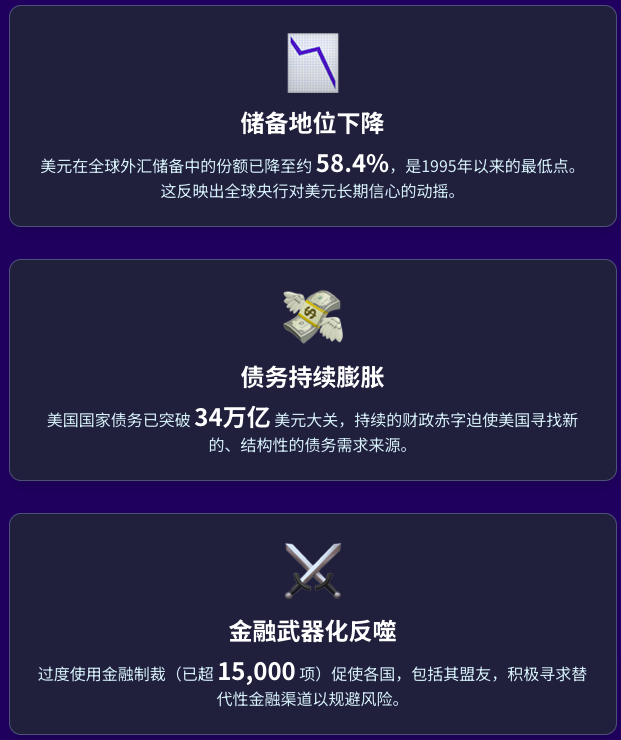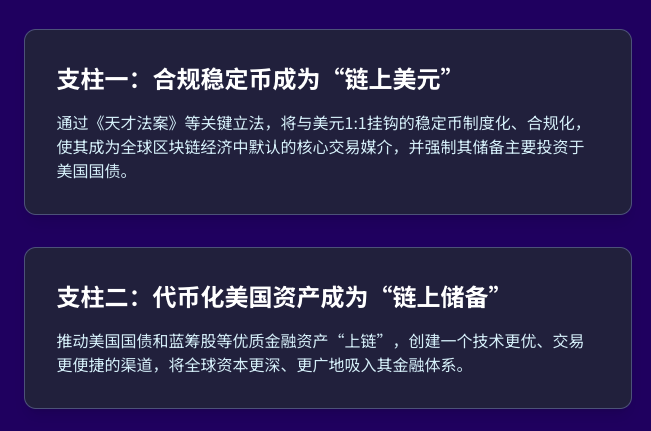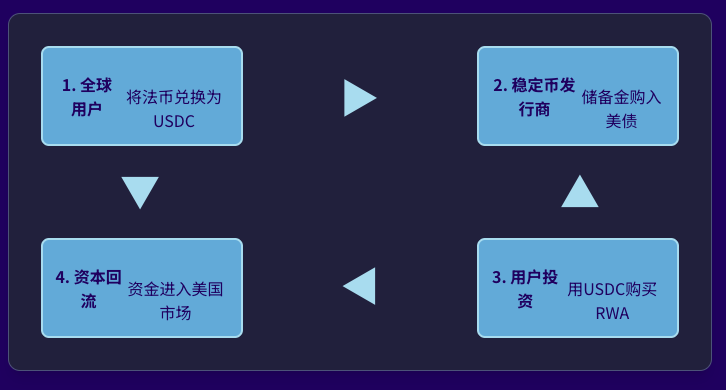The United States is reshaping its global financial hegemony through stablecoins and U.S. stocks.
For decades, the dollar has seemed to hold an unassailable hegemonic position in the global financial system. However, in recent years, geopolitical tensions, the ongoing expansion of debt, and the "weaponization" of financial sanctions have led to a backlash, gradually weakening the dollar. Although the process is slow, the trend is evident.
The three major issues currently facing the dollar are:
1. Declining reserve status
2. Continuous debt expansion
3. Backlash from financial weaponization
Now, the core strategy of the United States relies on two pillars: compliant dollar stablecoins and tokenized U.S. quality assets. The goal is to build a parallel, technology-driven dollar value network that deeply binds the global digital economy to the dollar ecosystem once again. On-chain dollars solve circulation and payment issues, while on-chain U.S. stocks provide quality assets, effectively depriving third-world countries of their minting rights.
➤ The first pillar: Regulated "on-chain dollars" — transforming global demand into U.S. Treasury purchasing power.
The first pillar of the U.S. strategy is to establish compliant dollar stablecoins as the default medium of circulation in the global digital economy. Recent key legislation, such as the Lummis-Gillibrand Payment Stablecoin Act, has accelerated the formal inclusion of mainstream stablecoins like USDC into the federal regulatory framework.
The brilliance of this legislation lies in its requirement that stablecoin issuers must invest the vast majority of their reserves in highly liquid quality assets, with short-term U.S. Treasury bonds being the core option. This means that every purchase and use of digital dollars in the global market will almost equate to an indirect purchase of U.S. government debt.
This mechanism has found a continuous, global new buyer for the massive U.S. national debt. When users in Asia purchase USDC for cross-border payments, or when investors in South America use stablecoins to enter the decentralized finance (DeFi) market, most of the funds exchanged from their fiat currency will flow to the stablecoin issuers, who will then buy U.S. Treasury bonds as reserves. According to industry experts and some research institutions (such as the Atlantic Council), as the stablecoin market expands (expected to reach trillions of dollars by 2030), this mechanism is likely to effectively alleviate the issuance pressure of trillions of dollars in U.S. debt in the coming years, converting external demand into direct support for U.S. finances.
➤ The second pillar: Tokenized "on-chain U.S. stocks" — attracting global capital.
If stablecoins solve the "liquidity" problem of the dollar, then the second pillar of the U.S. strategy aims to address the "attractiveness" problem — that is, to "tokenize" the highest quality financial assets of the U.S., such as U.S. Treasury bonds and blue-chip stocks, making them the preferred digital reserve assets for global investors.
Marked by the launch of the tokenized fund BUIDL by Wall Street giant BlackRock, the BUIDL fund converts high-credit U.S. short-term Treasury bonds into digital tokens that can be traded globally on the blockchain 24/7. This model, known as "real-world asset tokenization" (RWA), significantly lowers the entry barriers for global investors.
In the past, an ordinary investor from a country wanting to purchase U.S. Treasury bonds or stocks had to go through cumbersome processes of account opening, currency exchange, and cross-border transfers. Now, theoretically, anyone from any region can conveniently invest in these core U.S. assets with just a digital wallet. As BlackRock CEO Larry Fink stated, "The tokenization of any stock or bond is the next generation of financial development." This unprecedented accessibility is creating a powerful capital attraction, efficiently drawing global savings into the U.S. capital markets.
These two pillars do not exist in isolation; they form a sophisticated, self-reinforcing capital loop. Global users exchange their local currency for USDC, and stablecoin issuers then invest their reserves in U.S. Treasury bonds; subsequently, users use USDC to purchase tokenized U.S. stocks or bond funds. Starting from the wallets of global users, this supports U.S. debt, which ultimately flows back into the U.S. capital markets.
This loop cleverly bypasses many barriers and frictions in the traditional financial system, maximizing efficiency through blockchain technology. It injects new vitality into the circulation of the dollar and finds broader global buyers for U.S. core assets, representing not only an upgrade of the existing financial order but potentially a decisive shift in the future of global financial hegemony.
Show original


15.77K
63
The content on this page is provided by third parties. Unless otherwise stated, OKX is not the author of the cited article(s) and does not claim any copyright in the materials. The content is provided for informational purposes only and does not represent the views of OKX. It is not intended to be an endorsement of any kind and should not be considered investment advice or a solicitation to buy or sell digital assets. To the extent generative AI is utilized to provide summaries or other information, such AI generated content may be inaccurate or inconsistent. Please read the linked article for more details and information. OKX is not responsible for content hosted on third party sites. Digital asset holdings, including stablecoins and NFTs, involve a high degree of risk and can fluctuate greatly. You should carefully consider whether trading or holding digital assets is suitable for you in light of your financial condition.

